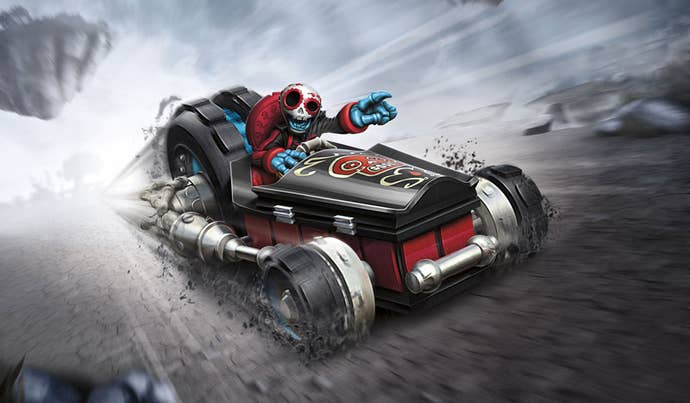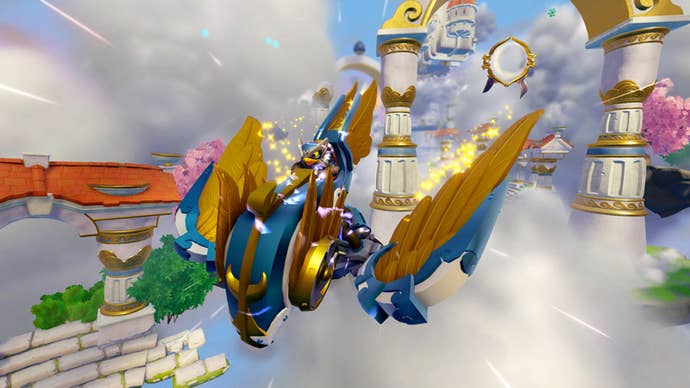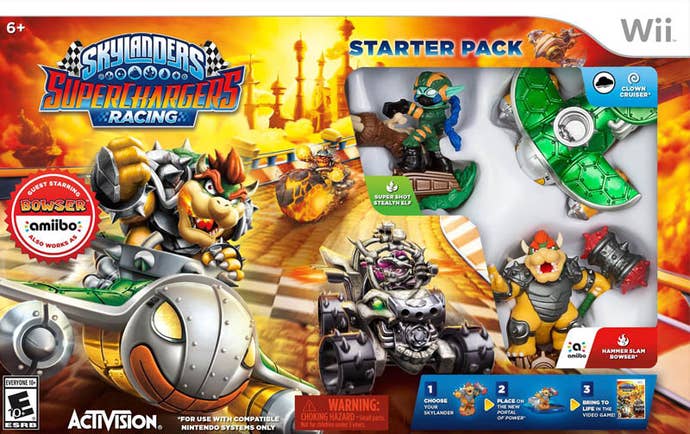Skylanders Superchargers Wii U Review: It's About Ethics in Toy-Based Games
Activision's latest toys-to-life creation goes heavy on quality, light on opportunism.
This article first appeared on USgamer, a partner publication of VG247. Some content, such as this article, has been migrated to VG247 for posterity after USgamer's closure - but it has not been edited or further vetted by the VG247 team.
I have to admit, I've really come around on the Skylander series. My initial impression of the franchise was "Great, yet another boring Spyro the Dragon platformer, now with living room clutter," which is quite a far cry from how I see it today: Namely, as arguably the best kids-oriented game franchise on the market.
Part of the change in perception has to do, I'm sure, with the fact that a couple of years ago my cool, urban life in trendy San Francisco drew to a close and my wife and I relocated across the country to surround ourselves with her family—a family that includes something like half a dozen preteens. Since then, I've seen plenty of kids-oriented games up close and personal, and it turns out they're mostly quite terrible. Sloppily designed, insultingly written, and (especially on mobile platforms), loaded down with rapacious microtransactions. It's the sort of thing to send Kanye West on a social media rant rampage, but for my part it's simply heightened my appreciation of the legitimately good kids' games.

Skylanders Superchargers isn't merely a good kids' game, though; more importantly, it's arguably a notch above other efforts in the burgeoning toys-to-life market that the franchise kicked off several years ago. Disney Infinity, LEGO Dimensions, and whatever Nintendo is doing with Amiibo all have their merits, but Skylanders quite impressively has managed to hold its own despite this growing competition. Considering the series has to stand up against products that benefit from the added punch of globally beloved characters and media properties (versus Skylanders' own bestiary of (almost) entirely original creations), quality really is the most important weapon in the series' arsenal. Maybe Skylanders can't allow you to play as Kylo Ren the day The Force Awakens debuts in theatres, but Superchargers makes up for it by offering plenty to enjoy in the here-and-now.
First, there's the question of microtransactions. They may take a different form in games like this than in, say, an iOS title, but they exist all the same. Rather than simply buying in to the game through in-app purchases, you have to buy toys — which begin at $13 and run all the way up to $35 for certain combo packs. This year's Superchargers theme brings $15 vehicles into the mix, requiring you to have both a character and a vehicle in play at the same time. While this could potentially have opened the door for some real financial abuse, forcing hapless parents to shell out hundreds upon hundreds of dollars on top of the base price of the game in order for their kids to get the most out of their game, in practice that's not really the case.
On the contrary, the add-on requirements for Superchargers feel much less steep than in previous years. Compared to last year's Trap Team in particular, Activision and Superchargers developer Vicarious Visions appear to have taken a step back and said, "Let's go easy on their wallets this time." Where Trap Team revolved heavily around the series' 11 elemental forces, essentially demanding players buy not only a character for each element but also a trap—a pricey translucent hunk of plastic that could capture a single enemy—you can experience the vast majority of Superchargers by buying just two vehicles in addition to the fire-themed land vehicle that comes with the starter set. You'll rarely see areas gated off by asking for toys of specific elements; instead, the overwhelming majority of obstructions come down to requiring either a land, sea, or air vehicle. This isn't to say elemental affinity doesn't play some role in the game, but it's more for dealing bonus damage in different zones than anything else.

As a result, Superchargers feels far less exploitative than its competitors. Essentially the entire game is available right up-front, with very little additional content locked away behind extra purchases. The most significant is the need to buy racing "action packs" in order to gain access to all the in-game race tracks and unlock villains and mirrored tracks; at the moment, only one of these $35 packs (the sea racing pack) is available. In any case, these extra races are completely optional and simply double the number of tracks included with the starter set (or quadruple, if you count mirrored tracks separately). Also, aside from a single, mandatory introduction to the mode, racing is entirely optional, so the racing packs feel entirely discretionary.
In fact, "discretionary" is how I'd describe most of the add-on purchases in Superchargers. Rather than locking away material behind expensive toys, the game instead treats collecting as a means by which to enhance the game. Any of the vehicles can be piloted by any of the characters—including the hundreds of legacy figures from older game versions already on the market—but pairing a vehicle with its specific driver character will activate both cosmetic enhancements and combat bonuses. There are something like 20 unique vehicles, which means 20 specific pilots, so the cost can add up quickly... though, again, it's in no way necessary. You can see the overwhelming majority of the game, and earn the majority of stars and bonus objectives, with just a handful of extra toys.
Compared to the way Dimensions and Infinity parcel out content and lack entire modes and storylines behind expensive add-on toys, I would describe Superchargers as refreshingly ethical. It gives players more or less the entire game right at the outset, and the toy-specific content essentially exists as bonus material for completists.

Commendable as the series' kinder, gentler (on the wallet) approach may be, Superchargers itself deserves praise as well for simply being a good game. It features by far the most varied and creative design of any Skylanders title to date; the series has come a long way from the low-stress platforming and mindless brawling of its early days. I wouldn't necessarily describe Superchargers as innovative, but it's certainly inventive, and nearly every chapter of the game revolves around a unique gameplay hook. Some of these concepts work better than others; the world where characters constantly reorient themselves relative to the camera sounds better in concept than in practice, due mainly to some rather fussy controls. On the other hand, the storybook world in which everything plays out as a sidescroller with paper cut-out environments and constant running narration has more than enough charm to make up for its slightly mundane platform design.
Basically, Skylanders' greatest strength is that it always feels like its creators are trying. While a fairly simple game at heart, it rarely talks down to players; about the most intrusive gameplay advice I ever saw was the NPCs' insistence on telling me to take out enemies who could heal other bad guys every single time a healer appeared. Otherwise, the constant running commentary exists more for narrative and humor; in all but a handful of cases, Superchargers seems happy to let players figure out all the goals and secrets on their own. That's not just rare in kids' games, it's rare in games, period. I get the impression that Vicarious Visions feels confident enough in the quality of their work and the intelligence of their audience to let players sort through it all on their own, and the game is better for it.

Speaking of the narrative, it's expectedly clever. Never laugh-out-loud funny; more like "groaning at dad jokes" funny, loaded with puns and drollery. As usual, the running commentary comes not from your legion of interchangeable heroes but rather from the core NPCs, their corny dialogue given genuine life and appeal by comic actors like Patrick Warburton and Cam Clarke. That said, the game script is outmatched by the visual humor invested into the game; each and every level includes tons of blink-and-you'll-miss-’em sight gags and throwaway jokes. The level midway through the adventure, in which your team is shrunken down to insect size, is a great example: An obsessive collector tracks your every move, lampooning the "mint in package" collecting mentality as she looms over the action, squealing with delight when you enter a vehicle stage ("You come with your own vehicle!?"). But even as you're beset by this seemingly giant woman, the stage is packed with lots of tiny details as well. At one point, a team of new enemies makes its debut in a short cutscene in which one creature gets its head stuck in a wire mesh door before its larger counterpart smashes open the cage door; once you defeat the enemies that come flooding out of the cage after the cutscene ends, that poor first monster remains stuck in the door, struggling in vain to break free. The time Vicarious Visions invested into needless throwaway details like that translates into a great game all around.
Special mention is due the last-generation versions of the game, which surprisingly don't feel like an afterthought compared to other platforms. While they lacks the visual enhancements of versions on more powerful consoles, the game plays smoothly and looks great even on older consoles. Additionally, all three Nintendo versions of Superchargers are particularly interesting for ditching the standard pack-in character and vehicle (Spitfire and his Hot Streak racer) in favor of a Nintendo character figure and custom vehicle; the Nintendo characters and vehicles only work on Nintendo systems due to obvious licensing limitations, and the figurines double as Amiibo with the turn of a switch. The armored-up Bowser is by far the most appealing Amiibo rendition of Bowser to date, standing with an arm extended in a pose that perfectly captures the kind of taunt you'd expect to see in a final battle in a Mario game. The downside: He comes exclusively with the 3DS and Wii versions of the game, which focus entirely on the racing component rather than the console versions' main adventure.
While no single element of Skylanders Superchargers feels particularly earth-shattering, every component of the game succeeds on its own term. Taken as a whole, the package offers an entertaining diversion for kids (or, yes, older players) that feels complete from the start. The toys-to-life category has increasingly become a painful, costly commitment, and Activision's choice to dial it back and lower the compulsory buy-in price for Superchargers feels refreshingly considerate—and, yes, even ethical.
InterfaceResponsive controls, though the inverted areas and some of the vehicles are (based on my observations) too complex for kids younger than, say, 8. And the figures and portal create a ton of real-world clutter...
Lasting AppealThe main adventure is quite expansive, enough to fill a few months of sugar-cereal-fueled weekend mornings. Add to that a ton of collectibles and unlockables and you have a long-term commitment.
SoundGiven the game's comical nature, the music sounds far more chill than you'd expect. Voice acting is top-flight Saturday morning cartoon fare.
VisualsCrisp, colorful, detailed graphics on all platforms, whether current gen or last.
ConclusionSkylanders may have created the toys-to-life category, but there are plenty of would-be heirs to the throne this year. Faced with stiff competition from Disney, LEGO, and Nintendo, Activision and Vicarious Visions chose to fight back by focusing on quality, breadth of play concepts, and a more affordable buy-in for the game. The resulting creation is the best Skylanders game to date, and a strong competitor to all those upstarts. Even the new Skylander characters, who initially seem a bit over-designed, grow on you after a few hours of play. If you're going to invest a ridiculous amount of cash into games that link up with collectible figurines, you could do a lot worse than Superchargers.
